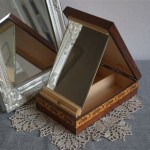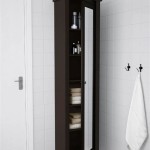Large Mirror Wall Fixings
Mounting a large, heavy mirror securely on a wall requires careful consideration of various factors, including the mirror's weight, the wall's construction, and the desired aesthetic. Choosing the correct fixings is crucial for ensuring safety and preventing damage to both the mirror and the wall.
Key Considerations for Choosing Fixings
Several factors influence the selection of appropriate fixings:
- Mirror Weight: Heavier mirrors necessitate stronger fixings with higher weight capacities.
- Wall Type: Different wall types (e.g., drywall, concrete, brick) require different fixing types. Drywall anchors, for instance, are unsuitable for heavy mirrors on plasterboard walls.
- Mirror Size: Larger mirrors require more fixing points for even weight distribution and to prevent tilting.
- Location: High-traffic areas or locations prone to vibrations might require more robust fixings.
Types of Large Mirror Wall Fixings
Various fixing methods exist for securing large mirrors:
- Heavy-Duty Mirror Clips: These clips grip the edges of the mirror and are secured to the wall with screws. They offer good support and are suitable for moderately heavy mirrors.
- J-Channels: J-shaped channels are mounted on the wall, and the mirror slides into the channel. This method offers excellent stability and is suited for large, heavy mirrors. It also allows for easier installation and removal.
- Z-Clips: These clips consist of two interlocking parts: one attached to the wall and the other to the back of the mirror. Z-clips provide a concealed fixing method, creating a flush, clean look. They are suitable for heavy mirrors and offer good stability.
- French Cleats: A French cleat system uses two interlocking wooden strips, one mounted on the wall and the other on the mirror. This method provides a strong, secure hold and is suitable for very heavy mirrors.
- Mirror Adhesive: Specifically formulated mirror adhesives can be used in conjunction with mechanical fixings or, in some cases, as the sole fixing method for lighter mirrors. Adhesive can help distribute weight and prevent vibrations. Always consult the adhesive manufacturer’s guidelines for weight limits and appropriate substrates.
Installation Best Practices
Proper installation is critical for safe and secure mirror mounting:
- Accurate Measurements: Precise measurements are crucial for correct placement of fixings and ensuring the mirror hangs level.
- Wall Stud Detection: Whenever possible, fixings should be anchored into wall studs for maximum support. A stud finder can help locate these structural supports.
- Appropriate Fixings for Wall Type: Use the correct wall plugs and screws designed for the specific wall material (e.g., drywall anchors for plasterboard, masonry anchors for brick or concrete).
- Weight Distribution Ensure the fixings are evenly spaced to distribute the mirror's weight effectively. Multiple fixings are essential for large mirrors.
- Pre-Drilling Pilot Holes: Pre-drilling pilot holes prevents cracking and splitting, especially in harder wall materials like brick or concrete. It also ensures accurate screw placement.
Safety Precautions
Safety should always be a priority when installing large mirrors:
- Wear appropriate safety gear: Safety glasses and gloves protect against dust, debris, and potential sharp edges.
- Use the correct tools: Employing the right tools for the job ensures efficient and safe installation. This might include a drill, screwdriver, level, stud finder, and measuring tape.
- Seek assistance: Large mirrors are heavy and awkward to handle. Enlist the help of another person to lift and position the mirror during installation.
- Check local building codes: Ensure the chosen fixings and installation methods comply with local building regulations and safety standards.
Choosing the Right Fixings for Different Wall Types
Different wall types require specific fixings:
- Drywall/Plasterboard: Toggle bolts, hollow wall anchors, or heavy-duty drywall anchors are generally suitable for lighter mirrors. For heavier mirrors, it's often best to find and fix directly to wall studs.
- Concrete/Brick: Masonry anchors, such as concrete screws or expansion bolts, are required for these solid wall types.
- Stud Walls: Secure directly into the wooden studs for the strongest hold. Use appropriate wood screws of adequate length and gauge.
Maintaining Your Mirror and Fixings
Regular maintenance can help prevent issues:
- Periodic Inspection: Regularly check the fixings for any signs of loosening or damage.
- Tightening Loose Screws: If any screws become loose, tighten them carefully, ensuring not to overtighten and damage the wall or the mirror.
- Cleaning: Clean the mirror and the surrounding wall area regularly to remove dust and debris that could potentially affect the fixings.
Consider Professional Installation
For extremely large or heavy mirrors, or for those who lack experience with DIY projects, professional installation is highly recommended. Professional installers have the expertise and tools to ensure safe and secure mounting, mitigating the risk of accidents or damage.

Heavy Picture Mirror Hanging Kit 50 Kg

5 X Sets Of Heavy Duty Mirror Fixings With Instructions

Large Wall Mirror Information

Large Mirror Hanging Fixings Picture Wall Bracket Nickel Repair Fix Set S

Chrome Adjustable Large Mirror Brackets Picture Hanging Set Bracket Wall Fixing

Lockable Heavy Duty Mirror Fixings

Large Wall Mirror Information

Picture Hanging Kit Mirror Hanger 40kg Picturehanging

4 X Large Picture Hanging Brackets Brass Flat Wall Mirror Hanger Plate Sisi Ltd

How To Hang A Large Or Heavy Mirror








